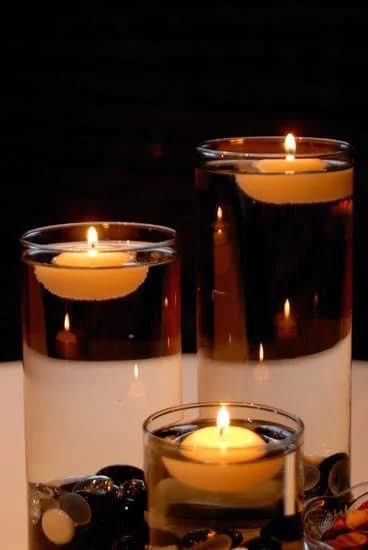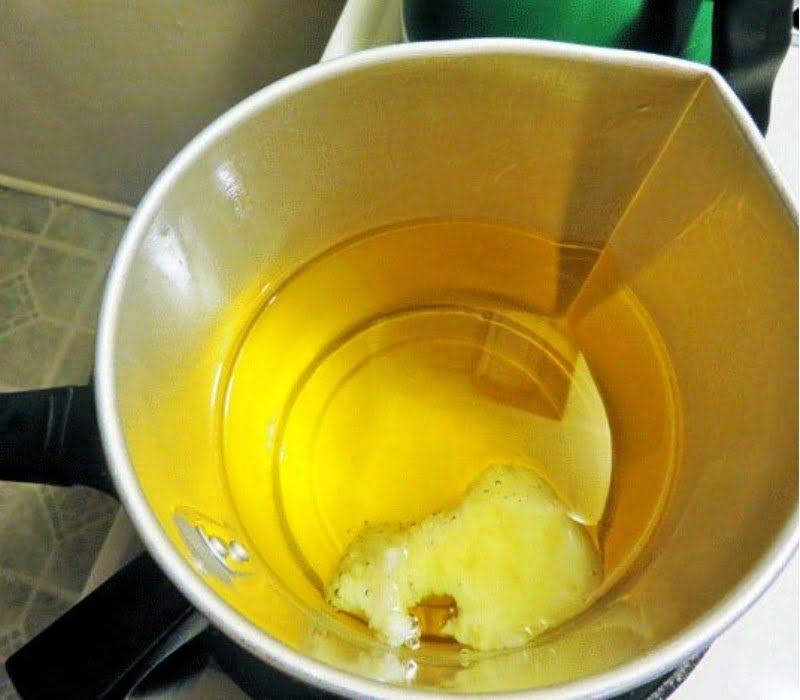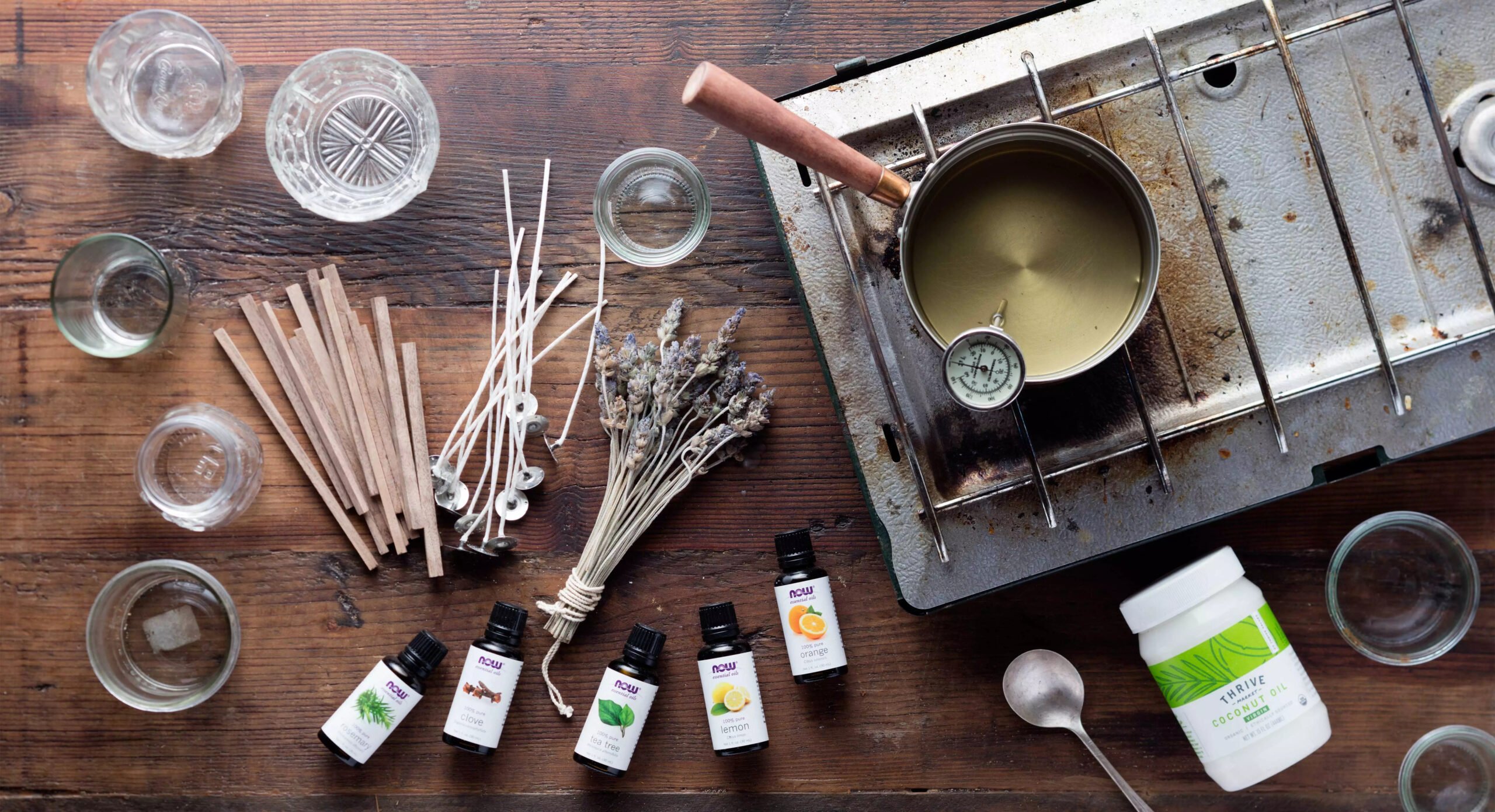The world of candle making is a captivating one, offering endless possibilities for creating beautiful and fragrant candles. One of the key factors in achieving success in this craft lies in choosing the right oils to use.
There are two main types of oils commonly used in candle making: essential oils and fragrance oils. Understanding the differences between these two types of oils and their respective benefits and drawbacks is crucial for any candle maker looking to create high-quality candles.
Essential oils, derived from various plants, have been used for centuries for their natural therapeutic properties and enticing scents. These precious oils are extracted through a meticulous process that involves steam distillation or cold-pressing. The result is highly concentrated aromatic compounds that capture the essence of plants such as lavender, peppermint, or eucalyptus. Each essential oil possesses unique properties that contribute to its scent profile and potential health benefits.
On the other hand, fragrance oils are synthetic or artificially created blends designed specifically for scenting candles. Unlike essential oils, they do not possess any natural therapeutic properties but offer a wide range of scents that can mimic fragrances found in nature or create entirely new and imaginative combinations. Fragrance oils provide consistency in scent throw and tend to be more affordable compared to their essential oil counterparts.
Choosing between essential oils and fragrance oils depends on several factors such as the purpose and atmosphere intended for the candles, safety considerations, personal preferences, and budget constraints. While both options have their advantages and disadvantages, it’s important to approach candle making with an informed perspective to ensure that the chosen oil perfectly complements the desired end product.
So whether you’re a seasoned candle maker or a beginner looking to embark on this creative journey, understanding the different characteristics of essential oils versus fragrance oils will help you make educated decisions when crafting your next batch of candles. With proper knowledge about these oils’ nuances, you’ll be well-equipped to create exquisite candles bursting with fragrance that will enchant any space they illuminate.
Understanding Essential Oils for Candle Making
Essential oils play a significant role in the art of candle making, offering a wide range of scents and therapeutic benefits. To fully appreciate their value, it is important to understand what essential oils are and how they are extracted.
Essential oils are highly concentrated plant extracts that capture the aromatic compounds from various parts of plants such as flowers, leaves, and stems. These oils carry the distinctive scent and natural properties of the plant they come from. Each essential oil has its own unique profile and offers different benefits when used in candle making.
Extracting essential oils involves several methods, including steam distillation, cold pressing, and solvent extraction. Steam distillation is the most common method used, where steam is passed through the plant material to release the oil. The resulting mixture of steam and oil is then condensed to separate the water from the oil.
Popular essential oils used in candle making include lavender, eucalyptus, peppermint, and citrus oils such as lemon and orange. Lavender essential oil is known for its soothing properties and is often used in candles designed for relaxation or sleep. Peppermint essential oil creates a refreshing aroma that can help invigorate the mind and body.
| Essential Oil | Origin | Main Properties |
|---|---|---|
| Lavender | Europe | Soothing, calming |
| Eucalyptus | Australia | Cleansing, invigorating |
| Peppermint | Mediterranean region | Refreshing, energizing |
Using essential oils in candle making offers numerous benefits. In addition to their captivating scents, essential oils possess natural therapeutic properties that can enhance the ambiance and mood of a space. For example, certain essential oils can promote relaxation, focus, or even relieve stress when released into the air through burning candles.
Despite their many advantages, there are some considerations when working with essential oils in candle making. Essential oils are highly concentrated and must be used sparingly to avoid overpowering the scent or causing irritation. It is important to properly measure and blend essential oils with candle wax to achieve the desired strength of aroma.
Overall, understanding essential oils for candle making is crucial for selecting the right scents and achieving the desired effects through aromatherapy. By harnessing the power of these natural extracts, candle makers can create beautiful and impactful candles that provide both aesthetic pleasure and therapeutic benefits to those who use them.
Benefits and Drawbacks of Using Essential Oils in Candle Making
When it comes to candle making, essential oils have become a popular choice for adding fragrance. These oils, derived from natural plant materials, offer not only pleasant scents but also potential therapeutic benefits. One of the main advantages of using essential oils is their natural and holistic properties. Unlike synthetic fragrance oils, which are created artificially, essential oils are extracted directly from plants through various methods such as distillation or cold-pressing.
The use of essential oils in candle making also allows for a greater connection with nature and the environment. Many candle makers appreciate the organic and pure qualities that essential oils bring to their creations. Additionally, these oils can provide a range of therapeutic benefits depending on the specific oil used. For example, lavender essential oil is known for its calming properties, while citrus oils like lemon or orange can uplift moods and create a refreshing atmosphere.
Despite their many advantages, there are also some drawbacks to using essential oils in candle making. Firstly, they tend to be more expensive compared to fragrance oils due to the extensive process required to extract them. This cost factor may be a deterrent for some candle makers who are working on a tight budget or producing candles in large quantities.
In addition, working with essential oils requires careful consideration and experimentation in order to achieve desired scent combinations. The potency of essential oils can vary greatly, so finding the right balance within wax blends can be challenging.
To properly incorporate essential oils into candle wax, it is important to follow certain guidelines. Candle makers should begin by selecting high-quality essential oils that are specifically labeled for use in candles. It is recommended to start with small quantities and gradually increase the amount until reaching the desired scent strength.
Testing different ratios and experimenting with mixing different essential oil scents can help achieve unique combinations. It’s worth noting that some essential oils may have lower flash points than others, meaning they could potentially evaporate or burn off at a lower temperature. This consideration is crucial for maintaining the integrity of the scent in the finished candle.
While there are some limitations and challenges to working with essential oils, their natural and therapeutic benefits make them a compelling option for candle making. With careful research, experimentation, and proper handling techniques, candle makers can create stunning candles that not only emit delightful fragrances but also provide potential wellness benefits.
A Closer Look at Fragrance Oils for Candle Making
Differentiating Fragrance Oils from Essential Oils
When it comes to candle making, fragrance oils offer a wide range of scents and possibilities. Unlike essential oils, which are derived from natural sources such as plants and flowers, fragrance oils are synthetic compounds created in laboratories. These synthetic oils are specifically designed to replicate the aromas of various scents, including fruits, flowers, spices, and more.
One key advantage of fragrance oils is their ability to provide consistent scent performance. Because they are created in controlled environments, fragrance oils offer a more reliable and predictable aroma compared to essential oils. This consistency is especially valuable for those who want their candles to consistently emit a specific scent throughout the entire burn time.
Common Sources and Types of Fragrance Oils
Fragrance oils can be derived from a variety of sources, including fruits, flowers, spices, and even fantasy scents. They can also be inspired by popular perfumes or fragrances. Some commonly used fragrance oil types include floral (such as rose or lavender), fruity (such as apple or strawberry), spicy (such as cinnamon or clove), and fresh (such as ocean breeze or rainforest).
In addition to single-note fragrances, there are also complex blends available that combine multiple scents to create unique and captivating aromas. These blends allow candle makers to experiment with different combinations and create one-of-a-kind fragrance profiles for their candles.
The range of scents offered by fragrance oils is vast and allows candle makers to cater to various preferences and themes. Whether you’re looking to create a calming atmosphere with lavender or evoke holiday nostalgia with the warm scent of cinnamon, fragrance oils offer endless possibilities for customization in candle making projects.
Advantages and Disadvantages of Choosing Fragrance Oils in Candle Making
When it comes to candle making, fragrance oils offer a range of advantages that make them a popular choice among candle makers. Understanding these advantages, as well as the potential drawbacks, can help you make an informed decision when choosing between essential oils and fragrance oils for your candle making projects.
One advantage of using fragrance oils is their versatility. Fragrance oils are specifically formulated to provide a wide variety of scents and notes, allowing you to create candles with complex and unique fragrances. Whether you’re looking for sweet, floral, fruity, or musky scents, fragrance oils have a vast selection to choose from. Additionally, fragrance oils offer consistency in scent throw, meaning that you can expect the same level of fragrance intensity with each batch of candles.
However, it is important to consider some potential disadvantages when using fragrance oils in candle making. One drawback is that fragrance oils may not possess the natural properties and therapeutic benefits that essential oils offer. While some fragrance oils may contain synthetic ingredients designed to mimic natural scents, they may not provide the same wellness benefits as their essential oil counterparts. Additionally, some individuals may have allergies or sensitivities to certain chemicals used in fragrance oil formulations.
To properly handle and blend fragrance oils in your candles, there are a few key techniques to keep in mind. First, it’s crucial to follow proper safety guidelines and regulatory considerations when working with fragrance oils. This includes using appropriate measurements and proportions recommended by the manufacturer and ensuring proper ventilation in your workspace.
Additionally, understanding how different fragrance notes interact with each other can help you create harmonious scent combinations. Experimenting with blending techniques such as layering or mixing smaller quantities before committing to larger batches can also help you achieve desired results.
Factors to Consider when Choosing Between Essential and Fragrance Oils
When embarking on a candle making project, one of the most important decisions to make is whether to use essential oils or fragrance oils. Both options have their own unique characteristics and considerations, so it is essential to carefully evaluate the factors that will influence your choice.
One factor to consider when choosing between essential oils and fragrance oils is the intended purpose and atmosphere of the candle. Essential oils are known for their natural and therapeutic properties, offering a wide array of benefits such as relaxation, stress relief, and mood enhancement. Fragrance oils, on the other hand, provide a broader range of scents and possibilities.
If you are creating candles for aromatherapy purposes or seeking specific therapeutic effects, essential oils may be your best choice. However, if you are looking to create custom scents or replicate popular fragrance combinations, fragrance oils offer a wider variety of options.
Safety and regulatory considerations should also play a role in your decision-making process. Essential oils are derived from plants through a process of distillation or cold-pressing, making them more natural than fragrance oils which are synthesized in laboratories.
As a result, some individuals may be more inclined towards using essential oils due to concerns about synthetic ingredients or chemical additives in fragrance oils. Additionally, it is important to note that some essential oils have specific safety guidelines due to their potency or potential allergic reactions.
Finally, personal preferences and budget should be taken into account when deciding between essential and fragrance oils. Essential oils can be more expensive than fragrance oil counterparts due to their extraction process and higher concentration of plant material required. Fragrance oils tend to be more cost-effective while offering a greater variety of scents compared to essential oils.
Consider these factors: the purpose of your candle, safety concerns, personal preferences such as natural vs synthetic scents along with budget constraints before deciding on either an essential oil or fragrance oil for your candle making project. By carefully weighing these factors, you can make an informed decision and create beautiful, fragrant candles that meet your specific needs and expectations.
| Factors to Consider | Essential Oils | Fragrance Oils |
|---|---|---|
| Intended purpose and atmosphere of the candle | Natural and therapeutic benefits, specific therapeutic effects | Broad range of scents, custom scent combinations |
| Safety and regulatory considerations | Natural ingredients, potential allergic reactions | Synthetic ingredients, chemical additives concerns |
| Personal preferences and budget | Potentially more expensive due to extraction process and higher concentration | Cost-effective, wider variety of scents available at a lower price point |
Balancing Essential and Fragrance Oils for Custom Candle Blending
Creating custom candle blends is an exciting way to personalize your candle-making process and create unique scents. To achieve the perfect combination, it is essential to find the right balance between essential oils and fragrance oils. By carefully blending these oils, you can unleash your creativity and enhance the overall fragrance of your candles.
Unleashing creativity by blending essential and fragrance oils
Blending essential and fragrance oils allows you to have the best of both worlds. Essential oils derived from plants have natural therapeutic benefits, while fragrance oils offer a wide range of scents not found in nature. When combining these two types of oils, you have endless options for creating captivating aromas that are sure to impress.
One approach to blending is using essential oils as a base scent for their therapeutic properties and then adding fragrance oils for their unique and distinctive fragrances. For example, you could use lavender essential oil as a relaxation base scent and add a few drops of vanilla or bergamot fragrance oil for an extra touch of sweetness or brightness. Experimenting with different combinations can help you develop your signature blends that evoke specific moods or atmospheres.
Tips and tricks for achieving desired scent combinations
Here are some tips to help you achieve the desired scent combinations when blending essential and fragrance oils:
- Start with small amounts: Begin with small quantities of each oil until you are satisfied with the scent combination.
- Record your recipes: Keep track of the different ratios and combinations that work well together so that you can recreate them in the future.
- Consider scent categories: Group essential and fragrance oils into similar categories such as floral, citrus, woody, or spicy. This will help guide your blending choices.
- Use a dropper or pipette: These tools allow for precise measurement and better control when adding the oils to your candle wax.
- Allow the blend to develop: After blending the oils, let them sit for at least 24 hours to allow the scents to fully meld before using them in your candles.
Achieving the right balance between scent throw and natural properties
Finding the right balance between scent throw and natural properties is crucial. Scent throw refers to how well the candle releases its fragrance while burning. Essential oils typically have a lower scent throw compared to fragrance oils. To enhance scent throw, you can use higher concentrations of fragrance oils or add essential oils that are known for their strong aromatic properties.
However, it’s important not to overpower a candle with too much oil. Overloading a candle with fragrance oils can lead to excessive soot formation or poor burn quality. Additionally, certain essential oils may have specific safety considerations and usage rates due to their potency.
To strike the perfect balance, consider the intended purpose of your candle and how you want it to perform. Tweak the ratio of essential and fragrance oils based on factors like room size, desired strength of fragrance, burn time, and safety guidelines provided by suppliers.
By taking these factors into account and experimenting with different combinations, you can create candles that not only smell delightful but also provide a pleasing experience during use.
Expert Advice and Recommendations
Insights from experienced candle makers and industry professionals
When it comes to choosing between essential oils and fragrance oils for candle making, it’s always valuable to seek advice from experienced candle makers and industry professionals. These experts have a wealth of knowledge and can provide insights that may help you make an informed decision.
One important piece of advice shared by experts is to consider the purpose of your candle. If you are looking to create a candle with therapeutic benefits or natural properties, essential oils may be the preferred choice. Essential oils are derived from plants and carry unique scents that can promote relaxation, uplift moods, or even repel insects. Additionally, some essential oils have antibacterial or antifungal properties that can enhance the air quality in your space.
On the other hand, if you’re aiming for a wide variety of scents or want to recreate popular fragrance blends, industry professionals often recommend fragrance oils. Fragrance oils are specifically formulated to deliver consistent scent throw and come in an extensive range of options, including unique combinations not found in nature. They can also provide more control over the intensity of a scent, allowing for customization according to personal preferences.
Popular blends and combinations recommended by experts
Experts in the field suggest various blends and combinations of essential and fragrance oils that can result in beautiful, fragrant candles. One popular recommendation is to blend citrus essential oils such as lemon or orange with complementary citrus-scented fragrance oil for a refreshing and invigorating candle. This combination creates a vibrant burst of aroma when lit.
Another suggested blend is lavender essential oil combined with a lavender-scented fragrance oil. The addition of the fragrance oil enhances the overall potency and longevity of lavender’s relaxing properties. The result is a soothing candle perfect for winding down after a long day.
Experts also advise exploring different categories when blending essential and fragrance oils. For example, pairing floral essential oils like rose or jasmine with corresponding fragrance oils can create a well-rounded and complex floral scent that lingers in the air.
Addressing common concerns and misconceptions about essential and fragrance oils
Experienced candle makers and industry professionals often address common concerns and misconceptions surrounding essential and fragrance oils. One frequent misconception is that essential oils are always more natural or safer than fragrance oils. While it is true that essential oils are derived from plants, it’s important to note that not all natural substances are necessarily safe for use in candles. Some essential oils may have a higher risk of causing irritation or sensitization, making proper dilution and usage crucial.
Regarding fragrance oils, there is sometimes a concern about their synthetic nature. However, reputable suppliers ensure their fragrance oils comply with safety standards and regulations. They undergo thorough testing to ensure they are safe for use in candles. It’s also important to note that many essential oils undergo processes such as distillation or steam extraction, which can result in varying levels of natural components.
Experts emphasize the importance of purchasing high-quality oils from trusted suppliers to ensure the best results in candle making. Additionally, conducting small test batches before committing to larger projects is recommended to observe how different oil combinations perform and interact with wax.
By seeking advice from experts, experimenting with blends, and addressing common concerns, you can make informed decisions when choosing between essential and fragrance oils for your candle making endeavors. This expert advice can help you add both beauty and the desired scent to your handmade candles while ensuring a positive experience for you and those who enjoy your creations.
Conclusion
In conclusion, choosing between essential oils and fragrance oils is a crucial decision in the art of candle making. Both options offer their own unique benefits and drawbacks, and it ultimately comes down to personal preferences, budget constraints, intended purposes, and safety considerations. Throughout this article, we have explored the world of essential oils and fragrance oils, understanding their origins, extraction processes, properties, and the range of possibilities they offer in terms of scents.
Essential oils provide natural and therapeutic benefits to candle making, allowing for a diverse range of aromas that can enhance mood and contribute to overall well-being. However, working with essential oils can present its challenges such as cost limitations, limited availability of certain scents, and potential difficulties in incorporating them into candle wax properly.
On the other hand, fragrance oils offer versatility and consistency in scent options that are not always found in essential oils. They often provide a broader range of choices at more affordable prices. However, it is important to be cautious when handling fragrance oils due to their synthetic nature and potential allergenic effects.
Ultimately, to create beautiful fragrant candles that meet your desired atmosphere or purpose, it may be helpful to consider blending essential and fragrance oils together. This allows you to unleash your creativity by experimenting with different scent combinations while achieving the right balance between scent throw and natural properties.
In conclusion, making an informed decision regarding the choice between essential oils and fragrance oils will greatly contribute to the success of your candle making endeavors. By understanding the unique properties of each oil type and considering factors such as safety regulations, intended purpose of the candle, personal preferences, and budget constraints – you are well on your way to creating stunning candles that delight both visually and olfactorily.
So don’t hesitate to explore different oil combinations and let your creativity soar as you embark on this aromatic journey.

Welcome to my candle making blog! In this blog, I will be sharing my tips and tricks for making candles. I will also be sharing some of my favorite recipes.





